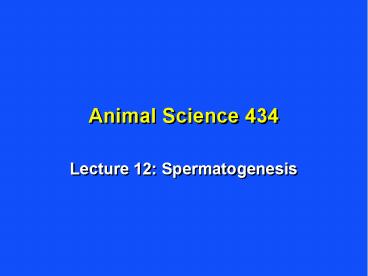Animal Science 434 PowerPoint PPT Presentation
Title: Animal Science 434
1
Animal Science 434
- Lecture 12 Spermatogenesis
2
Production of Fertile Sperm
- hormonal regulation of the testis
- mitotic division of spermatogonia
- meiotic divisions of spermatocytes
- morphologic transformation of spermatids into
spermatozoa
3
Hormonal Regulation of the Testis
4
FSH
FSH
FSH
FSH
5
Time of Day (24 hr)
Pulses are important !
6
- FSH on Sertoli Cells
- estradiol
- inhibin
- ABP
- tight junctions
Hypothalamus
GnRH
Ant. Pituitary
Leydig Cells
Sertoli Cells
Germ Cells
Seminiferous Tubule
7
Spermatogenesis
8
Sertoli Cell
Myoid Cells
9
Sertoli Cell
10
Every 13.5 Days sperm are released from this point
Spermatozoa
Round Spermatid
Secondary Spermatocyte
Primary Spermatocyte
Every 13.5 Days a new group of cells initiate the
cycle
Spermatogonia
11
Typical Sequence of Spermatogenesis
A
Spermatogonia (A, intermediate, B)
A
A
Spermato-cytogenesis
I
I
B
B
Primary Spermatocyte
Mitosis
P
P
Meiosis
S
S
SecondarySpermatocyte
RS
RS
Round Spermatid
Spermio-genesis
Spermatozoa
SP
SP
Spermiation
Rete Testis
12
Many Sperm are Produced
Potential Sperm Produced
1
A
2
A
A
4
I
I
8
B
B
16
P
P
32
S
S
64
RS
RS
SP
SP
13
Mitotic Divisions
- species dependent
- between 2 and 6 divisions (4 to 64 potential
daughter cells produced) - classifications vary among species and
investigators - A1, A2, A3, A4, B 1, B2, P
- Ad, Ap, B, P
- As, A0, A1, A2, I, B, P
- cytoplasmic bridges form between daughter cells
14
Cytoplasmic Bridges Present Among Daughter Cells
All develop surrounded by 1 Sertoli cell !
15
Germ Cells / Sertoli Cell
Species Primary Round Max. Potential Spermatocyte
s Spermatids Spermatids Equine 3.0 0.2 10.9
0.9 64 Bovine 1.2 0.1 5.2 0.6 64 Human 1.3
0.1 4.2 0.2 16
16
Apoptosis of Germ Cells
- Season
- Disease
- Trauma or heat
- Hormone levels
- Normal part of spermatogenesis
17
Stem Cell Renewal
- To keep spermatogenesis going indefinitely
- Replenish testis incase of injury, trauma, or
high heat
18
Periodic Entry of Cells into Mitosis
A2
Spermatogonial Renewal in the Rat and Bull
A1
Stem Cell Pool
A3
A4
In
B
P
19
Ap
Spermatogonial Renewal in the Primate
Ad
Stem Cell Pool
B
P
20
Stem Cell
21
Spermiogenesis
22
Golgi Phase
Development of Acrosome Migration of Centrioles
23
Cap Phase
Acrosome Development Continues Flagellum Elongates
24
Acrosomal Phase
Acrosome Manchette Elongation
25
Maturation Phase
Manchette disapears Mitochondria migrate Dense
fibers form
26
Spermiation
27
Spermiation
28
Temporal Relationships of Spermatogenesis
29
Spermatogenesis
57 days
Stallion
30
Multiple Generations of Germ Cells
31
Bull Spermatogenesis
32
(No Transcript)
33
Stages
- Specific cellular associations within a small
segment of a seminiferous tubule - stages are not the same length in time
34
Bull Spermatogenesis - Stages
35
Stages
- Specific cellular associations within a small
segment of a seminiferous tubule - stages are not the same length in time
36
Bull Spermatogenesis - Stages
37
Cycle
- progression through sequence of all stages
38
Bull Spermatogenesis - Cycles
39
Cycle
- progression through sequence of all stages
- 4.5 cycles to form spermatozoa
- some species variation
40
Duration of Spermatogenesis
41
Coordination of Stages Form Waves
- some portion of seminiferous tubule is always
releasing sperm
42
Compartmentalization of Spermatogenesisand
theBlood Testis Barrier
43
Seminiferous Tubule andInterstitial Tissue
44
Interstitial Tissue
- Vascular System Provides
- Nutrients
- Oxygen
- Growth Factors
- Hormones
45
Blood Vessel
46
Compartments
Luminal
Adluminal
Basal
47
Cycles and Stages
48
Compartmentalization
- Basal
- mitosis
- spermatogonia (A, I, B)
- primary spermatocytes
- Adluminal
- meiosis
- primary spermatocytes
- secondary spermatocytes
- spermatids
- spermiogenesis
- Lumen
- spermiation
49
Blood Testis Barrier
- Sertoli cells and associated tight junctions
- first appears at puberty
- induced by FSH
- after puberty can be maintained by FSH and/or
testosterone - essential for meiosis
50
Tight Junction Role in Meiosis
- Sertoli cells can manipulate environment around
1 spermatocyte - Enters meiosis
- Completes meiosis
- Destruction of TJ causes impairment of meiosis
- Heat, heavy metals, pesticides, lack of FSH or
Testosterone
51
Capacity for Sperm Production
Species Testis Sperm/gm DSP Weight (gm) (X
106) (X 109) Dairy Bull 650 18 10 Beef
Bull 500 18 8 Ram 550 26 14 Boar 750 30 25 Stallio
n 165 18 3 Man 40 4 .045 - .2
52
Duration of Spermatogenesis
53
Ap
Spermatogonial Renewal in the Primate
Ad
Stem Cell Pool
B
P
54
Capacity for Sperm Production
Species Testis Sperm/gm DSP Weight (gm) (X
106) (X 109) Dairy Bull 650 18 10 Beef
Bull 500 18 8 Ram 550 26 14 Boar 750 30 25 Stallio
n 165 18 3 Man 40 4 .045 - .2
55
Variation in Sperm Production
- Testis Size
- Efficiency of spermatogenesis
- mitotic division
- degeneration of germ cells
- Length of spermatogenesis
56
Apoptosis of Germ Cells
- Season
- Disease
- Trauma or heat
- Hormone levels
- Normal part of spermatogenesis
57
Over Population of Spermatogonia
Tight Junction
Sertoli
Sertoli
SG
SG
SG
SG
SG
SG
SG
SG
SG
Basement Membrane
58
Animation of Spermatogenesis
View the Animation of SpermatogenesisUsing the
Link at the Bottom of the Screen
- The objective is to see how the process of
spermatogenesis takes place over time and
involves both stages and cycles. - In the animation, the timing of events is correct
but we have taken liberties in moving groups of
cells from side to side to make room for
development of other cells. - The animation begins with primordial germ cell
migration into the primary sex chord and
replication of gonocytes to form stem cell A-Type
spermatogonia.

